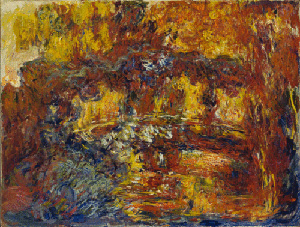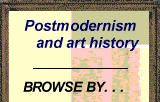Two Passages to Europe
John Haberin New York City
Monet and Venice
You could get through "Monet and Venice" without a trace of either Monet or Venice. After all, most rooms at the Brooklyn Museum stick to just one. You could say that you had seen two shows, one more luxuriant than the next. Go for it.
Testing the waters
Seriously, "Monet and Venice" opens without Monet. It has a thoroughly immersive first room, with large videos of the canals of Venice covering every wall. On-screen visitors to Italy seem in no hurry at all to move on, and neither do visitors to Brooklyn sharing their vision.  Either gets to fulfill a positive requirement of upper-class life back in the day, the European Grand Tour. From there, the exhibition opens onto a large set of prints of just that, by a little-known artist in the very next room. It embodied nothing less than an educated gentleman's or fashionable woman's proper education.
Either gets to fulfill a positive requirement of upper-class life back in the day, the European Grand Tour. From there, the exhibition opens onto a large set of prints of just that, by a little-known artist in the very next room. It embodied nothing less than an educated gentleman's or fashionable woman's proper education.
So by now does Claude Monet, whose oils quickly take over the show, if only briefly. Is this the very definition of a blockbuster? Maybe so, when either one, Monet or Venice, still embodies European painting and Europe's cultural memory. Maybe, too, when both approach cliché. What could be more beautiful than their sparkling light show? It could be the very embodiment of Europe's cultural memory. As for Post-Impressionism, it had already had come, and Modernism was on its way.
Monet's opening three works have a firm basis in what he knew so well, color. Large streaks reach to the sky, defying gravity or painterly tradition. Each makes a point of its defiance, as always with Monet. Each, though, takes care equal care with the facts—the plazas and palaces along the canal. Each, too, has just one dominant element, water. How much that element sets him apart.
Monet broke through to a new manner of painting early, side by side with Pierre Renoir at Argenteuil, up the Seine from Paris. Impressionism quite generally relied on cooperation, as with the Salon des Refusés that welcomed painters whom institutions refused to display. It relied, too, on work in series, as he set his easel on a boat and his painterly feet on the ground. It brought his haystacks, water lilies, and the watery garden at Giverny, and Brooklyn includes a panting from there as well. Rouen cathedral was not far from the English Channel or Waterloo Bridge from the Thames. They, too, became favorite subjects.
Monet stuck with them all, but the museum promptly abandons Monet. It doubles back in time for a blockbuster in miniature, of Venice. Its history starts anew in the 1700s with Canaletto and a more stately architecture. It extends forward parallel to the picture plane—to John Ruskin with The Stones of Venice and Paul Signac with Pointillism. J. M. W. Turner sets the sky aglow with seeming explosions, while Thomas Moran finds a heightened drama in the Hudson River School. John Singer Sargent moves in and out of doors, for a generation of high society with its own grand tour ever in progress.
Only then, after Sargent, does the show return to Monet as well. It can go only so far. Born in 1840, Monet arrived in 1868, after years of refusing the tourist trap. He completed just thirty-seven works before leaving for home in Giverny, promising a second visit that never took place. His wife had died, and he had no heart to go it alone. He died in 1926.
The fog is not lifting
The Brooklyn Museum can boast of two shows, with no need to choose, but you may yet be aware of its limits. Claude Monet painted just thirty-seven works in Venice. Judging by a map of the places in the city he lived and enjoyed, he covered a serious lot of ground. Yet it cannot conceivably survey either of its subjects. You will just have to trust that one map to follow in his footsteps. Monet himself is gone.
The curators, Brooklyn's Lisa Small and the Fine Art Museum of San Francisco's Melissa Buron, deftly manage its doubling back and forth. The doublings exist all the same. The show cannot help including Canaletto because this is still, after all, a city of canals. Yet it is neither the first nor the last that art has seen of Venice or Monet. It does not so much as attempt to ask how much Venice left its imprint in the artist's later work back in Giverny. Nor does it probe the reception he received while still in Venice.
Did his work change in the course of his stay? It is hard to say, although colors differ in those first three paintings from later ones. The former have brighter yellows that threaten to dissolve before your eyes. Did it affirm his Impressionism? Almost surely, but its sampling of the movement sticks to Renoir and Charles François Daubigny. Camille Corot offers a slightly arbitrary point of origins with his uncanny sunlight, and I myself found him vital in a preface to art criticism.
That clean, clear, colorful sky could last only so long before Monet's generation staked its claim. The museum points out the city's growing "sulfurous vapors." Not all the fog on canvas was from nature and this artist more than any would not lie to you. Had his deep reds, blues, and greens already departed? He cared about what he saw. He depended on it.
But was that enough, and did he come to Venice even a little bit for its history? I came just for that back in my twenties, and that includes art history. I promised to see everything there by Tintoretto and, before him, Titian in Renaissance Venice. I saw little else, but I had done my homework up front. Like Monet, I fear, I never returned. Still, it was Monet's Venice, too.
That Venice is still worth debating. Sargent puts in an appearance early, with an interior lit only by natural light. Its intensity is unmistakable, but it leaves much of the large room black. Its occupants, two men and two women, are mature enough to relish both the darkness and the light. Two later Sargents look to the outdoors for a brighter picture later in the exhibition. Did Monet see Venice the same way?

"Monet and Venice" ran at The Brooklyn Museum through February 1, 2026.




